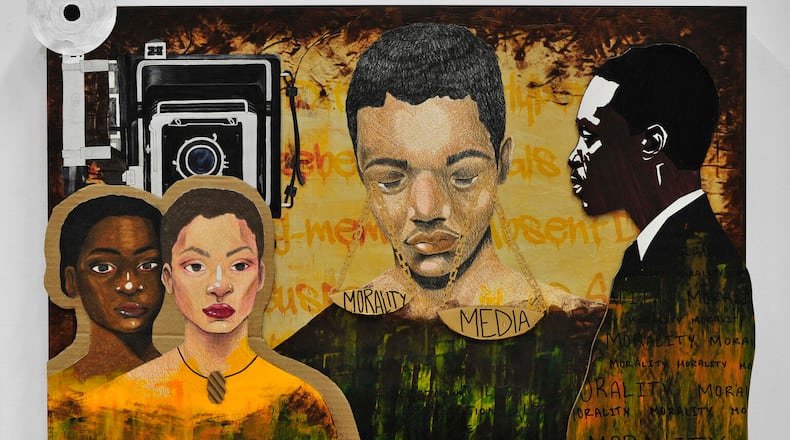“The speech is King’s only known speech in Dayton, delivered less than two weeks before he was awarded the Nobel Peace Prize,” organizers stated in a press release.
Credit: REGINALD HARMON
Credit: REGINALD HARMON
Curated by local artist and educator Willis “Bing” Davis, the thought-provoking exhibition of 29 works spotlights 13 African American artists, many from the Dayton area, who found inspiration in the ideas in King’s Dayton address.
“We asked them to go deeper and not be afraid to try something unique,” Davis said. “Some took a word, phrase or a theme. Others provided a conceptualization. So we ended up with a variety of techniques and processes from experimental and traditional to paintings and abstracts. It was a challenging show but it turned out especially well.”
The Kettering Foundation also spoke highly of their collaboration with Davis and the galleries.
“As a part of the Kettering Foundation’s work to advance inclusive democracy, we know that the arts hold unique power to challenge and inspire us to create the type of beloved communities that Dr. King so often spoke of,” said Sharon L. Davies, president and CEO of the Kettering Foundation, in the release. “We are deeply grateful to be able to work in partnership with community leaders like Bing Davis in shared pursuit of those goals.”
The showcased artists are: Karen Brame (“ASKIA: Power First but I’m Gonna Lead with My Best Foot Forward”); Breanna Cole (“We Have a Long, Long Way to Go”); Abner Cope (”Civil Rights Sermon,” ”Somebody,” “He Had His Dream,” “Virginia”); Dwayne Daniel (”Damn the Good Gold Days!,” “Healing Waters,” “Lessons From the Past”); Cliff Darrett (”We Have a Long, Long Way to Go”); Bing Davis (”Anti Police Brutality Dance Mask #22,” “Colin Kaepernick/George Floyd Knee Cushion #15,” ”Dr. Margaret Burroughs as Institution Builder,” “There is a Balm in Gilead West Dayton”); Gregg DeGroat (”The Mind Is the Standard of the Man”); Reginald Harmon (”Portrait of a King”); Kevin Harris (”Trayvon/Martin”); Morris Howard (”How Many Jellybeans Are in a Jar”); James Pate (”Critical Race Analytics #1,” “Critical Race Analytics #2,” “Race Analytics Mask #2,” “Winter Suit”); Craig Screven (”Conversation Piece at the Table 4,″ “Knowledge is the Key to Liberation”); and Erin Smith-Glenn (”Still Waters Run Deep,” ”The Honorable Joyce Beatty,” “The Spectrum of Nina Simone”).
In describing his work, Harris contemplates a thread between the legacies of King and Trayvon Martin.
“We’ve come a long, long way since 1619, but we have a long, long way to go,” Martin Luther King, Jr. said in 1964,” Harris stated. “He went on to say that lynchings of African Americans, frequent just 25 years earlier, had “by and large . . . ceased,” but that “tragic moments of violence and terror” still occurred in “communities in the South.” Four years later he succumbed to a single gunshot in Memphis, Tennessee. And in 2012, in Sanford, Florida, a child, Trayvon Martin, was hunted in the streets and executed. What if young Martin had not seen his 18th birthday? What if Trayvon had lived long enough to vote?”
Howard’s contribution examines Black voter registrations in the 1940s and 1950s and current photo ID requirements for voting.
“My agenda in creating this work was to illustrate that voter suppression is very much alive and well,” Howard said. “We can, however, do something about it by constantly educating ourselves, holding our elected officials accountable, and speaking out against these injustices. This is how I speak out: I do it through my art. As Dr. King said many times, ‘Anybody can serve.’”
Credit: MORRIS HOWARD
Credit: MORRIS HOWARD
Brame turned to sports for inspiration, particularly an iconic, controversial image from the 1968 Summer Olympics.
“‘ASKIA’ is inspired by the 1968 track and field Olympian John Wesley Carlos,” Brame said. “As the U.S. national anthem played during the medal ceremony, Carlos and fellow medalist Tommie Smith defiantly raised their black-gloved fists in solidarity with the Black Power movement. They wore black socks and no shoes to protest the treatment of African Americans. Stark contrasts between Eurocentric citizenhood and a heritage identity with the Africa diaspora are apparent. The silver chain and shells represent Black gifts, labor, talents, and lives that have been exploited, or stomped on, by the United States. The gold chain and shells symbolize commitment, freedom, and determination to develop and retain Black wealth and wellness. The lock and key connecting the chains’ links speak to tyranny and demands for liberty.”
Credit: KAREN BRAME
Credit: KAREN BRAME
She also said the title refers to West African Emperor Askia Muhammad I who built the Songhai empire.
“Askia can be translated as ‘leader,’ ‘one who seizes power,’ ‘one who strives for personal success and societal impact,’ and ‘he who represents the desire not just for personal success but for leaving his mark on the world,’' Brame said. “Indubitably, John Carlos is ASKIA!”
The exhibition will continue at Black Palette Art Gallery and EbonNia Gallery in the Wright Dunbar neighborhood through Feb. 2, 2025. Davis is hopeful the exhibition will tour after it closes to continue its relevant discussion of history, race, politics and social justice.
“This is a show that needs to travel and be seen by broader audiences if possible,” Davis said. “It’s going to help us deal with what we’re going to be dealing with in society, especially after the election.”
HOW TO GO
What: “Visual Voices: An Exhibition by African American Artists Inspired by Dr. Martin Luther King Jr.’s 1964 Dayton, Ohio, Speech”
Where: Black Palette Art Gallery (1139 W. Third Street) and EbonNia Gallery (1135 W. Third St.). Gallery hours are 11 a.m. to 5 p.m. Tuesdays through Saturdays.
When: Through Feb. 2, 2025. A reception will be held from 5 to 7 p.m. Dec. 13. Artists featured in the exhibition will be in attendance.
Cost: Free
More info: Call Black Palette Art Gallery at 937-723-9106 or EbonNia Gallery at 937-223-2290.
Credit: KEVIN HARRIS
Credit: KEVIN HARRIS
About the Author






